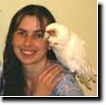What to Do When Your Bird Gets Sick
Kristen Reeves, Meadowlark Farms Avian Supply, Inc.
We all know that sick feeling we get when we see one of our birds in the bottom of the cage. It's not a nice feeling. But we can't allow ourselves to check out just yet. Our quick actions may very well save a sick or ailing bird! We need to move fast - we can collapse later!
Please note that these procedures are to STABILIZE your bird ONLY until you can get it to your Avian Veterinarian. Placing the bird in a heated cage will do nothing more than prolong the bird's life until the issue can be diagnosed. We are not Veterinarians and cannot in good conscience tell you how to treat unless we know the exact cause of illness after it has been properly diagnosed.
IMMEDIATELY –
-
Get the bird into a SMALL hospital cage. The point of a SMALL cage is to prevent them from expending more energy than necessary. The smaller the cage, the less they can move around. Flying and perching expends much more energy than you could ever imagine! I always keep one set up here. I don't want to have to be running around trying to set up a cage when a bird is down.
- Line the cage with NEWSPAPER - NOT paper toweling. There are two reasons for this. The first, paper toweling will soak up most of the droppings the bird may pass. You need to see what the droppings would look like before they are absorbed. The second, paper toweling is often "bleached". The bleach combines with the droppings and makes them change colors. You need to be able to see the color of BOTH the fecal and urine portions of a bird’s droppings to know what might be wrong. Once they combine with the bleach in the paper toweling, you may not be able to tell what color they are, and they will often look worse than if they'd been on plain paper.
- Get the bird some HEAT. If you are using a small wire cage, cover half the cage with a towel or blanket, leave the other half uncovered and place a heat lamp or bulb over the covered part of the cage. I use a red 25 watt party bulb in a hardware store clamp style trouble lamp (total including bulb, about $6). Heat the cage to approximately 80-85 degrees. You may need more or less heat - watch the bird for clues - if it starts to pant, it is too hot. If it stays fluffed and/or huddled, it may need more heat. However, you need to leave open space so the bird can escape the heat if it needs to. This is VERY important. Birds fluff to preserve heat. But fluffing expends energy. Heating the cage allows the bird to conserve energy because it won't need to fluff.
- If the bird is barely able or unable to raise its head, place a very shallow dish (like a jar lid or storage container lid) in the bottom of the cage filled with an electrolyte solution like Dr. Rob Marshall’s QuikGel. There are many solutions on the market. I prefer Quik Gel because it is sugar-free, but others may use NV Powder, Guardian Angel, etc. If the bird isn't moving around much, you can stand a flat bottomed drinker in the corner of the cage (like I do).
- For a bird that cannot lift its head at all, syringe feed the electrolyte solution like Dr. Rob Marshall’s QuikGel - ONE TINY DROP AT A TIME - into the beak. If the bird will not open its beak, touch the tip of the syringe right to the corner of the beak where upper and lower beak meet, and where it attaches to the birds head. Release a single drop in that spot. The beak acts like a sponge and will draw the fluid into the beak. The bird will begin to swallow. It is EXTREMELY important to only add one tiny drop at a time. A weak bird may not be able to swallow well. You don't want the bird to aspirate the solution.
- Add some kind of soft, easily eaten and easily digestible food to the cage. Bread soaked in milk, scrambled eggs (not cooked in butter), chitted or sprouted seed, Miracle Meal or Proteen with a tiny bit of electrolyte solution added to moisten it, etc. A sick bird needs every ounce of energy it can get. Offering soft foods allows the birds to get nutrients into its system without having to expend energy cracking seed hulls.
- Pay close attention. Some birds will start to act perfectly normal as soon as they warm up. Others will get too hot and begin to pant. You must pay attention when you have a bird in a hospital cage like this. You want to monitor fluid intake, as well as food intake. Monitor the droppings and, if you have the ability, test them for issues.
-
Lastly, GET THE BIRD TO YOUR AVIAN VETERINARIAN! Only a qualified professional should diagnose your bird. If you rely on someone who "thinks" they know, you may kill your bird. If you don't have an Avian Veterinarian near you, enter your information into this link and use the one closest to you:
Association of Avian Veterinarians - Find A Vet Form
FINAL WORD...
The information contained here is for reference purposes only. As always, if you suspect your bird is sick, take it to an Avian Veterinarian!





